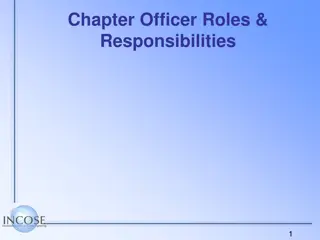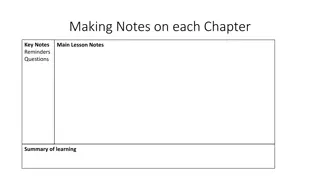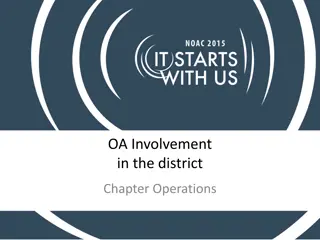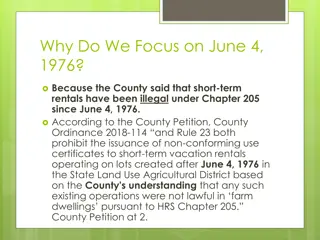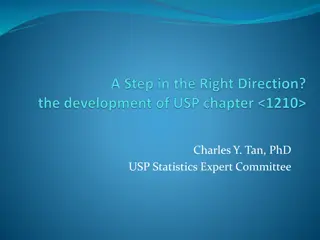
Understanding Financial Competencies and Strategies
Explore the essential competencies and skills required for finance professionals, with a focus on strategic financial management. Learn about the challenges, performance expectations, and the evolving role of finance in organizations. Enhance your understanding of the CGMA Competency Framework and the CIMA Approach to Qualification for financial excellence.
Download Presentation

Please find below an Image/Link to download the presentation.
The content on the website is provided AS IS for your information and personal use only. It may not be sold, licensed, or shared on other websites without obtaining consent from the author. If you encounter any issues during the download, it is possible that the publisher has removed the file from their server.
You are allowed to download the files provided on this website for personal or commercial use, subject to the condition that they are used lawfully. All files are the property of their respective owners.
The content on the website is provided AS IS for your information and personal use only. It may not be sold, licensed, or shared on other websites without obtaining consent from the author.
E N D
Presentation Transcript
STRATEGIC LEVEL F3 Financial Strategy Chapter 1: Introduction (C) Personal Use only. Any un-authorized use, copying or reproducing full or partial content is contravention of intellectual property act and unlawful. Failure to comply will be subjected to legal recourse.
CIMA Approach to Qualification Learning Systems Mindset and Competencies Challenges Performance They must Comprehend the performance needed from the finance team to address. Use learning to continually update their competencies and maintain a flexible mindset. Understand the competencies and mindset needed to perform Realize the challenges organizations face which threaten them. Increasingly the required skills of finance professionals are moving into the expert, problem-solving arena and they must adopt competencies involved in influencing and change management. The finance professional needs a mindset that enables them to adapt through continuous learning.
CGMA Competency Framework introduced in 2019 CGMA Competency Framework sets out the skills and competencies that are essential for the financial staffs across the industries. Apply accounting and finance skills For the first time, today s finance manager need to sensitize the technology and digital mindset they need to possess in playing out their roles in the organization and they influence the finance manager s decision, actions and behaviors. To the context of Business Technical Skills: Financial accounting and reporting, cost accounting and management, planning and control, management reporting and analysis, corporate finance and treasury management, risk management and internal control, taxation and accounting information systems. Lead within the organization Business skills: Strategy, analysis of market and macro-economic environments, process management, business relations, project management and awareness of the regulatory environment. To influence people Leadership skills: Team building, coaching and mentoring, driving performance, change management, and ability to motivate and inspire. People skills: Ability to influence, negotiation skills, decision-making, collaborative working and communication. Ethics, Integrity and Professionalism
Assessment of Practical Experience Strategic Level Certificate Level Management Level Operational Level BA1 Fundamentals of Business Economics Strategic Case Study Exam Operational Case Study Exam Management Case Study Exam E1 Organizational Management E2 Project and Relationship Management BA2 Fundamentals of Management Accounting Enterprise Pillar E3 Strategic Management BA3 Fundamentals of Financial Accounting P2 Advanced Management Accounting P1 Management Accounting P3 Risk Management Performance Pillar F3 Financial Strategy F1 Financial Reporting and Taxation BA4 Fundamentals of Ethics, Corporate Governance and Business Law F2 Advanced Financial Reporting Financial Pillar
Assessment of Practical Experience Award / Membership of the Chartered Institute of Management Accountants and the CGMA designation Strategic Level Management Level Award : CIMA Advanced Diploma in Management Accounting (CIMA Adv Dip MA) 40% Operational Level Award : CIMA Diploma in Management Accounting (CIMA Dip MA) 30% Certificate Level 50% Award : CIMA Certificate in Business Accounting (CIMA Cert BA)
CIMA Qualification Framework Strategic Level CIMA definition on Strategic Level: The Strategic level focuses on long term strategic decision making. Candidates will be able to support organizational leaders to craft strategy; evaluate and manage risks that might prevent organizations from successfully implementing strategy; value organizations; and source financial resources required to implement of strategy. CIMA defines the Finance Pillar under which Financial Strategy subject falls: The Financial pillar focus is the financial accounting and reporting obligations of the organization. This includes an understanding of the regulatory framework and external reporting requirements, and the ability to construct and evaluate complex financial statements to show the financial position and performance of the organization. The fundamentals of business tax are covered, as are the tax implications of financing decisions. It also looks at formulating financial strategy, which is linked to the formulation of organizational strategy in the enterprise pillar and assessing risk in the performance pillar.
Syllabus Context Beyond the scope of the syllabus; covered by CPD Strategic leadership of the finance team to achieve desired impact Strategic Level and covered by Continued Professional Development (CPD) Strategic partnership through interaction with internal and external stakeholders to influence and shape how the organization creates and preserves value Technical specialists generate insights about value creation and preservation in their respective areas Management Level Managing processes and applying accounting rules to assemble and extract data to provide information and insight Operational Level
Strategic Level Summary On completion candidates should be able to: support organizational leaders to craft strategy; evaluate and manage risks that might prevent organizations from successfully implementing strategy; Value organizations; and Strategic Management Formulate Strategy and create conditions for successful implementation E3 Source financial resources required to implement of strategy Wide Scope Fully Integrated Financial and both quantitative and qualitative nonfinancial Future and some present Long Term Decision making External combined with internal (whole organization) Aggregate (fewer details) Influence. Risk Management Analyze, evaluate and manage strategic, operational and cyber risk. P3 Financial Strategy Create Financial strategy, evaluate and manage financial risk and assess organizational value F3
What do you learn in F3- source cimaglobal.com Analyze and evaluate the sources of long-term finances to meet the organization s financing requirements Identify, assess and manage financial risks associated with cash flows and capital projects . Make financial policy decisions that align to the organization's strategic objectives Develop and apply business valuation techniques to measure the tangible and intangible value of the organization.
10 Strategic Level F3 Content Weighting The weighting given below is the weightage for each main course content for F3 Financial Strategy and students should not confuse the weights as percentage of testing in the examinations. Content Area Weighting A. Financial Policy Decision 15% B. Sources of Long-Term funds 25% C. Financial Risks 20% D. Business Valuation 40% Total 100%
11 F3 Financial Strategy - Brief Syllabus S.No Topics of the Subject Syllabus A Financing Policy Decisions Profit and not-for-profit organizations Quoted and unquoted companies Private and public sector organizations Value for money, maximizing shareholder wealth Earnings growth, dividend growth Impact of underlying economic conditions and business variables on financial objectives Enhancing the value of other non-financial capitals (human capital, intellectual capital and social and relationship capital) United Nations Sustainability Development Goals. Use of policy decisions to meet cash needs of entity Sensitivity of forecast financial statements and future cash position to these policy decisions Consideration of the interests of stakeholders. Lenders assessment of creditworthiness Consideration of domestic and international tax regulations Consideration of industry regulations such as price and service controls. B Sources of Long-Term Funds Capital structure theories (traditional theory and Miller and Modigliani (MM) theories) Calculation of cost of equity and weighted cost of capital to reflect changes in capital structure Impact of choice of capital structure on financial statements Structuring debt/equity profiles of companies in a group. Types of debt instruments and criteria for selecting them Managing interest, currency and refinancing risks with target debt profile Private placements and capital market issuance of debt Features of debt covenants. Methods of flotation and implications for management and shareholders Rights issues, choice of discount rates and impact on shareholders Calculation of theoretical ex-rights price (TERP) and yield adjusted TERP.
12 F3 Financial Strategy - Brief Syllabus S.No Topics of the Subject Syllabus C Financial Risks Economic risk Political risk Currency risk Interest rate risk Theory and forecasting of exchange rates (e.g. interest rate parity, purchasing power parity and the Fisher Effect) Value at risk. Responses to economic transaction and translation risks Operations and features of swaps, forward contracts, money market hedges, futures and options Techniques for combining options in order to achieve specific risk profile such as caps, collars and floors Internal hedging techniques. D Business Valuation Reasons implications of management buy-outs Acquisition by private equity and venture capitalist. Asset valuation Valuation of intangibles Different methods valuation (share prices, earnings valuation, dividend valuation, discounted cash flow valuation) Capital Asset Pricing Model (CAPM) Efficient market hypothesis. Forms of consideration Terms of acquisition Target entity debt Methods of financing cash offer and refinancing target entity debt Bid negotiation. Post-transaction value incorporating effect of intended synergies M&A integration and synergy benefit realization Exit strategies. for M&A and divestments Taxation implications Process and of equity
THANK YOU (C) Personal Use only. Any un-authorized use, copying or reproducing full or partial content is contravention of intellectual property act and unlawful. Failure to comply will be subjected to legal recourse.

